When Sugar Is Not Sweet – OpEd
Sugarcane farmer Noel Biklas will not be happy here even if the world celebrates International Day of Happiness on March 20 .So are thousands more like him.
It is not difficult to understand why. Sun-burnt at 56 summers, he does one of the country’s most difficult and lowly paid jobs ten hours a day. One of the 700,000 (Master Plan For the Philippine Sugar Industry. Sugar Master Plan Foundation, Inc. 2010. pp. 4–6. ) “sacadas” (sugar cane plantation worker) slaving in endless lands of the few rich billionaires in the country, he earns less than two dollars a day.(Master Plan For the Philippine Sugar Industry. Sugar Master Plan Foundation, Inc. 2010. p. 5.)
On annual basis, production of sugar contributes about 69.7 billion pesos to the Philippine national GDP with Value Added Tax (VAT) collection for the sale of refined sugar reaching over 1.92 billion pesos yearly.
Biklas and his kind plod through itchy and rough cane fields wielding three feet machetes or bolos through steaming heat, dirt and sweat to cut cane for sugar that is exported to the USA, Europe and Japan.
He retires only when darkness overpowers daylight to feast on a bowl of rice and small dried fish left by his family of six who sleeps on a rough coconut timber as floor, covered by a sack. A place they call home.
Barely visible a mile away is an opulent mansion towering over the far-reaching expanse of canefields costing hundreds of thousands of dollars. The house of Noel’s landlord.
Sacadas like Noel have toiled for four generations on their landlords’ hacienda.. His grandfather, father and two sons are sacadas like him. “My children’s children will be like me, there is no place else to go,” he says with a defeated far-away look.
Indeed, the thousands of fathers working as sacadas in the Philippines, are finding it difficult to get out of their cycle of poverty.
Most sacadas live in darkness. They are nailed to the earth.
The plight of the Sacadas in the Philippines is best exemplified by those living in the island of Negros Occidental. They are underpaid, ill-treated, and deprived of every basic human rights, including members of their families, the National Federation of Sugar Workers (NFSW) in the Philippines say.
“Many starve and remain at the mercy of their patriarchs—the landowners—who will decide what to pay them, how much, when and what they and their family members can and cannot do”, it added.
NFSW estimates there are more than 500,000 sacadas in the Philippines. This does not include fathers’ sons and even wives and daughters enslaved by the inhuman backbreaking labor of sugar plantations.
Sacadas are the Philippine’s living proof that colonial-period migrant labor in the Philippines persists in the “new millennium.” The ordinary sacada is the oppressed worker, migrant, and peasant twice over. Receiving abysmally-low wages and denied benefits, many of the sacadas hail from the Visayas islands, where many hacienda landowning families are found, Irish priest Fr. Niall O’Brien of the Negros Diocese says after working in the province for 40 years.
The tragedy experienced by sacadas is nowhere more real than in November 2004 when soldiers and policemen attacked and killed more than a dozen sacadas and arrested more than a hundred others sacadas who were protesting their low pay and inhuman treatment. The hacienda they worked at is owned by the family of Corazon C. Aquino, former president of the Philippines.
The harsh and difficult working and living conditions of the sacada and his family is worsened by people contracting sacadas to work in haciendas. Fr. Arnesio Jesena, S. J. Of the Ateneo de Manila University lived with sacadas in at least ten areas in the Philippines says “Sacadas and their families are helpless when under contractors because they cannot dictate their own terms. They are often abused by these contractors.”
He had this to say: “When I lived with the sacadas like a sacada, here were 200 of us — men, women, and children staying in two adjoining cuartels.”
“There was not a single toilet.”
“There was only one source of water — an old pump. Here everyone did his or her washing, bathing, laundering. We had no blankets, no mosquito nets.”
“For food, three times a day we were served rice — the cheapest, driest, coarsest, most unappetizing I have ever tasted. Many of the grains were unhusked, and there were pieces of gravel to be found among the grains of rice. We were also given fish — small, dry fish (pinamalhan nga sapsap). Rough rice and dry fish, that was all. No liquid, no vegetables, a diet which gave no delight and no strength.”
Fr. Jesena’s tale is written a book called “The Sacadas of Sugarland”.
During the term of late President Cory Aquino, the Comprehensive Agrarian reform Program (CARP) was launched with the intention of providing land to the landless like the sacadas. But it met little success mainly because the landowners were the politicians themselves and never pushed the national law with will. Only a handful politician-landowners willingly parted from their lands.
Now 34 years after, the CARP program will end. But to the sacadas and their families, the CARP was just a story in the wind, blown away like their fading hopes of escaping poverty that is slowly breaking their very souls.

